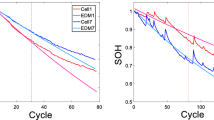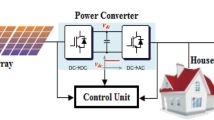Abstract
This paper investigates the application of modal analysis in the results of a proposed robust state estimation technique to determine the most critical buses of power distribution systems within the context of voltage stability assessment. In the proposed approach, the Weighted Least Squares (WLS) technique is used to estimate state variables based on micro-PMUs (Phasor Measurement Units) and SMs (smart meters) measurements. The estimated voltage magnitudes and angles are used to form a reduced Jacobian matrix which provides the sensitivities of reactive powers and voltage magnitudes at each load bus. Based on the calculation of eigenvalues and eigenvectors, participation factors are estimated for each load bus. In order to minimize the influence of gross errors, a bad data detection procedure is performed using Chi-squared test. The proposed identification procedure is based on the Median Absolute Deviation (MAD) of the normalized measurement residuals. The corrupted measurements are re-weighted in the proposed methodology to suppress its influence on the results yielding high accurate estimates. Simulations are carried out using a 33-bus test system. The impact of distributed generation units, aleatory errors and bad data is evaluated by different case studies to prove the efficiency of the proposed method.























Similar content being viewed by others
References
Melo ID, Oliveira BC, Antunes MP (2021) Voltage stability assessment using modal analysis based on power systems state estimation. Electr Eng 104(2):577–586
Oliveira BC, Melo ID, de Souza MA (2021) Bad data detection, identification and correction in distribution system state estimation based on pmus. Electr Eng 104(3):1573–1589
Su Q, Wang H, Sun C, Li B, Li J (2022) Cyber-attacks against cyber-physical power systems security: state estimation, attacks reconstruction and defense strategy. Appl Math Comput 413:126639
Yang N-C, Liu M-J, Lai K-Y, Adinda EW (2022) Three-phase power flow calculations using initial voltage estimation method for unbalanced distribution networks. IEEE Access
Karvelis GI, Korres GN, Darmis OA (2022) State estimation using scada and pmu measurements for networks containing classic hvdc links. Electric Power Syst Res 212:108544
Huang T, Sun H, Wu Z, Zong X, Li Y, Wang Y, Tang J, Li X, Mo Y, Li C et al (2022) A scada/pmu hybrid measurement state estimation method considering load uncertainty. IOP Conf Ser Earth Environ Sci 983:012008
Abur A, Expósito AG (2004) Power system state estimation: theory and implementation. CRC Press, Boca Raton
Jin Z, Zhao J, Chakrabarti S, Ding L, Terzija V (2020) A hybrid robust forecasting-aided state estimator considering bimodal gaussian mixture measurement errors. Int J Electr Power Energy Syst 120:105962
Abood HG (2020) Monitoring and state estimation of modern power systems. Smart Technologies for Smart Cities. pp 87–107. Springer, Berlin
Schweppe FC, Wildes J (1970) Power system static-state estimation, part i: exact model. IEEE Trans Power Appar Syst 1:120–125
Schweppe FC, Rom DB (1970) Power system static-state estimation, part ii: approximate model. IEEE Trans Power Appar Syst 1:125–130
Schweppe FC (1970) Power system static-state estimation, part iii: implementation. IEEE Trans Power Appar Syst 1:130–135
Salgado AR, Esquivel CRF, Guizar JGC (2015) Scada and pmu measurements for improving power system state estimation. IEEE Lat Am Trans 13(7):2245–2251
Dobakhshari AS, Azizi S, Abdolmaleki M, Terzija V (2020) Linear lav-based state estimation integrating hybrid scada/pmu measurements. IET Gener Transm Distrib 14(8):1583–1590
Kabiri M, Amjady N (2018) A new hybrid state estimation considering different accuracy levels of pmu and scada measurements. IEEE Trans Instrum Meas 68(9):3078–3089
Pourbagher R, Derakhshandeh SY, Golshan MEH (2022) A novel method for online voltage stability assessment based on pmu measurements and thevenin equivalent. IET Gener Transm Distrib 16(9):1780–1794
Teixeira MO, Melo ID, João Filho A (2021) An optimisation model based approach for power systems voltage stability and harmonic analysis. Electric Power Syst Res 199:107462
Ajjarapu V, Christy C (1992) The continuation power flow: a tool for steady state voltage stability analysis. IEEE Trans Power Syst 7(1):416–423
Gao B, Morison G, Kundur P (1992) Voltage stability evaluation using modal analysis. IEEE Trans Power Syst 7(4):1529–1542
Bi T, Qin X, Yang Q (2008) A novel hybrid state estimator for including synchronized phasor measurements. Electric Power Syst Res 78(8):1343–1352
Huang M, Wei Z, Sun G, Zang H (2019) Hybrid state estimation for distribution systems with ami and scada measurements. IEEE Access 7:120350–120359
Kumar CS, Rajawat K, Chakrabarti S, Pal BC (2020) Robust distribution system state estimation with hybrid measurements. IET Gener Transm Distrib 14(16):3250–3259
de Oliveira BC, Pereira JL, Alves G d O, Melo I D, de Souza M A, Garcia PA (2018) Decentralized three-phase distribution system static state estimation based on phasor measurement units. Electric Power Syst Res 160:327–336
Primadianto A, Lu C-N (2016) A review on distribution system state estimation. IEEE Trans Power Syst 32(5):3875–3883
de Souza MA, Pereira JL, Alves G d O, de Oliveira B C, Melo I D, Garcia PA (2020) Detection and identification of energy theft in advanced metering infrastructures. Electric Power Syst Res 182:106258
Baran ME, Wu FF (1989) Optimal capacitor placement on radial distribution systems. IEEE Trans Power Deliv 4(1):725–734
Bhonsle J, Junghare A (2012) A novel approach for the optimal pmu placement using binary integer programming technique. Int J Electr Electron Eng (IJEEE) 1(3):67–72
Rakpenthai C, Uatrongjit S (2015) A new hybrid state estimation based on pseudo-voltage measurements. IEEJ Trans Electr Electron Eng 10:S19–S27
Acknowledgements
This study was financed in part by the Coordenação de Aperfeiçoamento de Pessoal de Nível Superior—Brasil (CAPES)—Finance Code 001. The authors would also like to thank UFJF (Universidade Federal de Juiz de Fora) and PPEE (Programa de Pós Graduação em Engenharia Elétrica).
Author information
Authors and Affiliations
Corresponding author
Additional information
Publisher's Note
Springer Nature remains neutral with regard to jurisdictional claims in published maps and institutional affiliations.
Appendix A: nonlinear functions
Appendix A: nonlinear functions
The nonlinear function \({\mathbf {h}}({\hat{\varvec{x}}})\) represents the estimated values calculated as function of the state variables in such a way that active/reactive powers, active/reactive flows and the branch currents can be determined from (28) to (30):
The elements of the Jacobian matrix related to active power measurements with respect to voltage angles and magnitudes are presented in (35).
The elements corresponding to the reactive power measurements are presented in the set of equations (36) with respect to voltage angles and magnitudes.
The elements of \({\mathbf {H}}\) corresponding to the PMUs voltage magnitudes and angles are presented in (37) and (38), respectively.
The partial derivatives related to the branch currents measurements magnitudes provided by PMUs are given by equations (40). The elements corresponding to the branch currents angles are provided in (40).
where \(A_{km}, B_{km}, C_{km}, D_{km}\) are defined by (41):
Rights and permissions
Springer Nature or its licensor (e.g. a society or other partner) holds exclusive rights to this article under a publishing agreement with the author(s) or other rightsholder(s); author self-archiving of the accepted manuscript version of this article is solely governed by the terms of such publishing agreement and applicable law.
About this article
Cite this article
Mingorança, J.S., Melo, I.D. & Santos, A.B.d. Critical buses identification for voltage stability assessment considering the application of modal analysis and a robust state estimation with bad data suppression. Electr Eng 105, 335–348 (2023). https://doi.org/10.1007/s00202-022-01677-3
Received:
Accepted:
Published:
Issue Date:
DOI: https://doi.org/10.1007/s00202-022-01677-3




